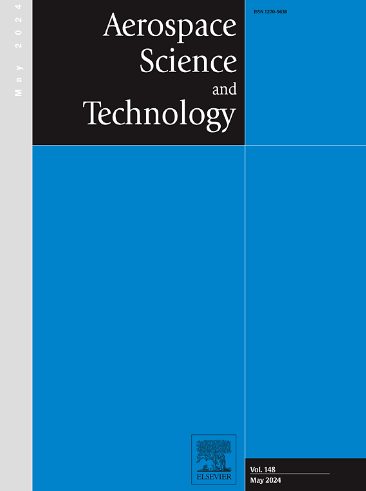Sensor placement for optimal aerodynamic data fusion
IF 5.8
1区 工程技术
Q1 ENGINEERING, AEROSPACE
引用次数: 0
Abstract
Aircraft design is recently evolving towards a digital twin representation that involves many heterogeneous data sources. The aerodynamic development of aircraft usually incorporates data from computational fluid dynamics simulations, wind tunnel testing, and flight tests. All of these data sources have their advantages and disadvantages, which can optimally be combined using data fusion methods. However, the quality of the data fusion result strongly depends on the experimental design, i.e. the placement of discrete sensors. Therefore, an optimized sensor placement is essential for data fusion applications, as the number of sensors is limited. This work presents a sensor placement strategy for the widely used Gappy proper orthogonal decomposition data fusion methodology. The sensor placement relies on a Bayesian formulation of the data fusion, allowing accurate error estimates. Based on the Bayesian posterior, a utility function characterizes the quality of the fused result by quantifying the expected information gain for the proper orthogonal decomposition coefficients. As the optimization of the sensor locations involves a complex combinatorial problem, we introduce an efficient genetic algorithm for this task. The method is demonstrated on a two-dimensional airfoil and the NASA Common Research Model with synthetic measurement errors. For both test cases, an optimal sensor placement results in smaller reconstruction errors than a conventional layout. The Bayesian approach leads, in most cases, to more accurate reconstructions and is more versatile than other well-established sensor placement methods. The proposed genetic algorithm finds better optima with significantly fewer function evaluations than the widely used greedy algorithms.
优化空气动力数据融合的传感器布局
最近,飞机设计正朝着数字孪生表示的方向发展,其中涉及许多异构数据源。飞机的空气动力开发通常包含来自计算流体动力学模拟、风洞试验和飞行试验的数据。所有这些数据源各有优缺点,可通过数据融合方法进行优化组合。然而,数据融合结果的质量在很大程度上取决于实验设计,即离散传感器的布置。因此,在传感器数量有限的情况下,优化传感器位置对数据融合应用至关重要。本研究针对广泛使用的 Gappy 适当正交分解数据融合方法,提出了一种传感器布置策略。传感器的布置依赖于数据融合的贝叶斯公式,从而实现精确的误差估计。基于贝叶斯后验,一个效用函数通过量化适当正交分解系数的预期信息增益来表征融合结果的质量。由于传感器位置的优化涉及一个复杂的组合问题,因此我们引入了一种高效的遗传算法来完成这项任务。该方法在二维机翼和具有合成测量误差的 NASA 通用研究模型上进行了演示。在这两个测试案例中,最佳传感器位置的重建误差都小于传统布局。在大多数情况下,贝叶斯方法能带来更精确的重构,而且比其他成熟的传感器布置方法更具通用性。与广泛使用的贪婪算法相比,所提出的遗传算法能以更少的函数评估次数找到更好的最佳值。
本文章由计算机程序翻译,如有差异,请以英文原文为准。
求助全文
约1分钟内获得全文
求助全文
来源期刊

Aerospace Science and Technology
工程技术-工程:宇航
CiteScore
10.30
自引率
28.60%
发文量
654
审稿时长
54 days
期刊介绍:
Aerospace Science and Technology publishes articles of outstanding scientific quality. Each article is reviewed by two referees. The journal welcomes papers from a wide range of countries. This journal publishes original papers, review articles and short communications related to all fields of aerospace research, fundamental and applied, potential applications of which are clearly related to:
• The design and the manufacture of aircraft, helicopters, missiles, launchers and satellites
• The control of their environment
• The study of various systems they are involved in, as supports or as targets.
Authors are invited to submit papers on new advances in the following topics to aerospace applications:
• Fluid dynamics
• Energetics and propulsion
• Materials and structures
• Flight mechanics
• Navigation, guidance and control
• Acoustics
• Optics
• Electromagnetism and radar
• Signal and image processing
• Information processing
• Data fusion
• Decision aid
• Human behaviour
• Robotics and intelligent systems
• Complex system engineering.
Etc.
 求助内容:
求助内容: 应助结果提醒方式:
应助结果提醒方式:


